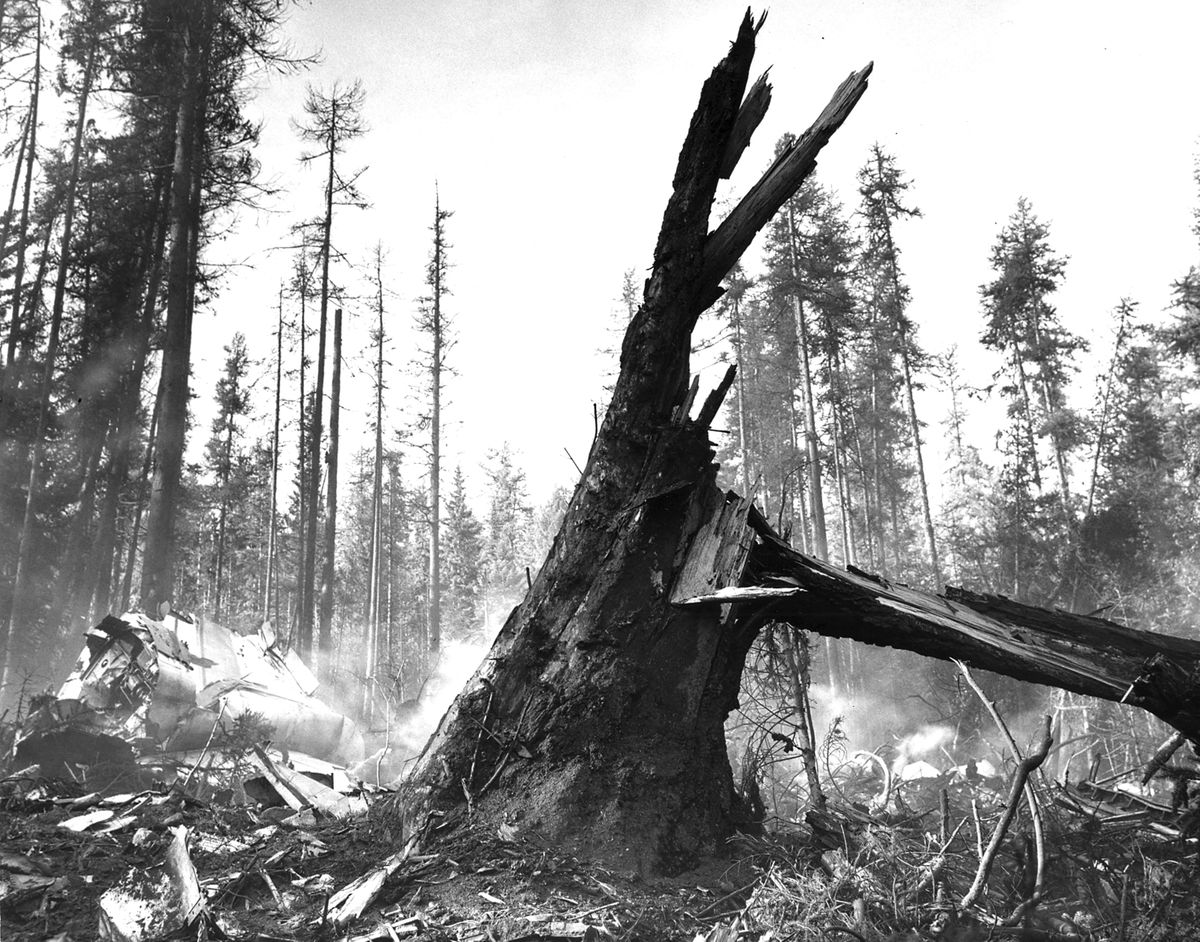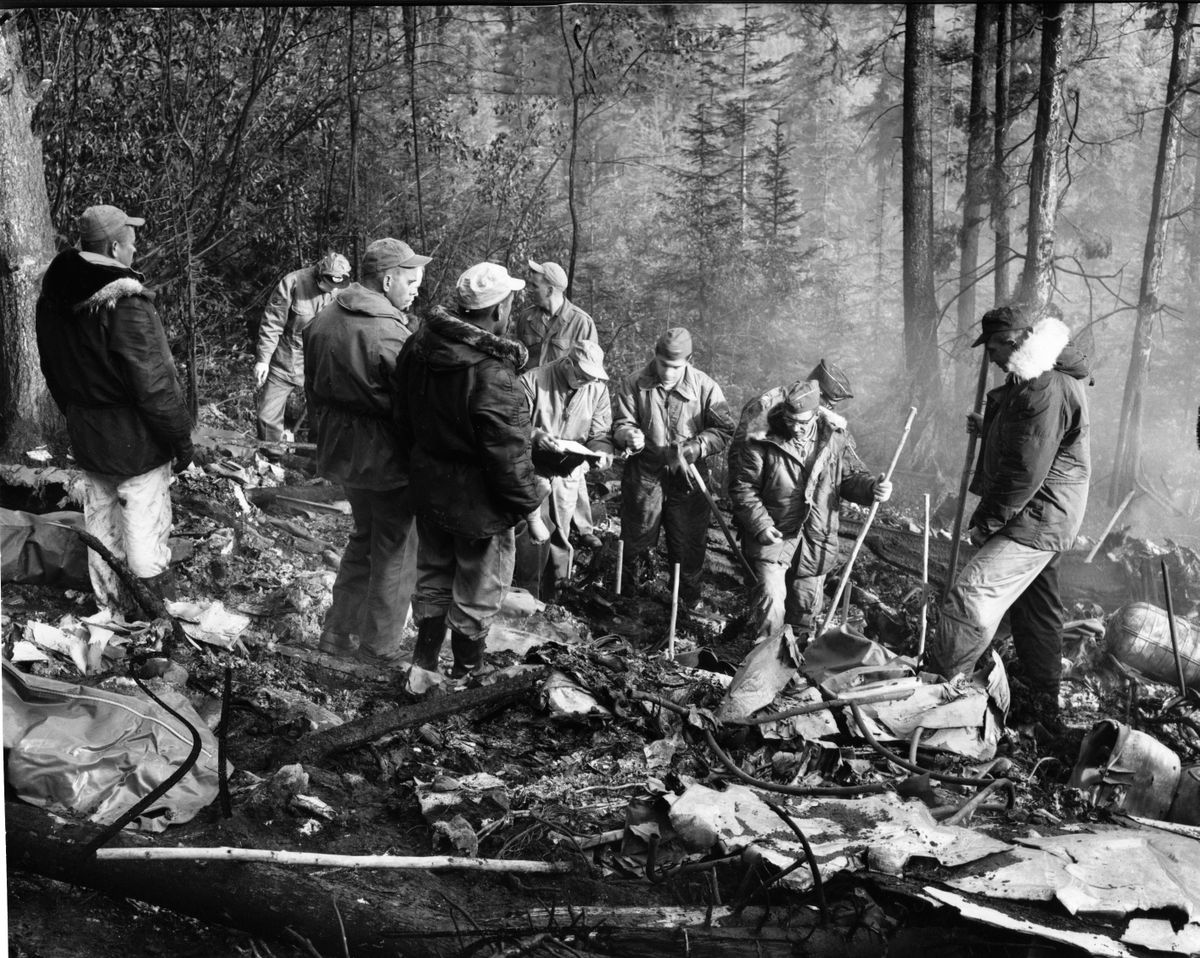50 years ago, 44 men died when KC-135 crashed before landing
The tragedy remains the worst of its kind in Spokane history
Fairchild airmen who had hoped to take part in a rescue mission became members of a salvage crew on Sept. 12, 1962, as they worked on the grim task of removing 44 bodies on Mount Kit Carson.
The KC-135 tanker was on its approach to Fairchild Air Force Base on a foggy September morning 50 years ago when the air traffic control tower lost radar and radio contact. The tanker, call sign Mourn 79, was due in from Ellsworth Air Force Base in South Dakota. It was somewhere west of Blanchard, Idaho, along a path that took it over Mount Spokane and Mount Kit Carson, when contact was lost.
Although a tanker usually carried a crew of four – pilot, co-pilot, navigator and boom operator – Mourn 79 had 44 on board. Ellsworth was getting ready to repair its runway, and the plane, along with other air and ground crews, and one civilian adviser who worked for a spark plug company, were being sent temporarily to Fairchild.
Because of the fog, the pilot, Capt. Frank Johnson, was approaching Fairchild on instruments. There was one peculiar thing about that approach to the West Plains base: There were actually two flight paths, very close together.
One had a minimum altitude of 4,500 feet as it came around the mountains. The other had a minimum of more than 8,000 feet because it came over the mountains.
At 10:45 a.m. on Sept. 10, 1962, Mourn 79 started its descent through the clouds and fog, the experienced crew apparently believing they were on track for the flight path around the mountains. They were headed straight for Mount Kit Carson, and they were about 800 feet too low.
When Mourn 79 disappeared from radar at 11 a.m., Fairchild officials mounted a massive search. Helicopters and motor vehicles from the base began searching the road between Elk and Blanchard. Spokane County sheriff’s deputies joined in the search and soon a reported 200 people were combing the area. Hours went by with no sign of the plane.
The initial theory was that the plane was down near the Idaho border, although Mrs. Arthur Strange, of Blanchard Valley, Wash., told the Spokane Chronicle no one had seen or heard a crash. But the land in question was fairly remote, she said, and uninhabited except for the 150 or so head of cattle the family had there.
By early afternoon, the call went out from the Sheriff’s Office for help in the search.
In north Spokane, Wayne Hamaan heard about the search. Fifty years later, he can’t remember if he heard it first on the radio or television, but he called his father, Irving, and a friend, Bert Smith, and the three decided to search an area on Mount Kit Carson where they’d spent some time hunting.
“We were more drinking buddies than anything else,” Hamaan, a retired railroad engineer, recalled recently.
Driving up an old road on Kit Carson, Hamaan smelled smoke. They pulled over to the side, and he and Smith got out. They started down the mountainside while his father stayed in the car because the terrain leading off the road was so rough, he said.
They hiked in maybe 50 yards before they came upon the beginning of the crash site. Rain had put out the fire, but the wreckage was still smoking. “The first thing I saw was a set of wheels, and a big piece of the vertical (stabilizer) rudder,” Hamaan said. He also saw what he thought were one or two bodies near the front of the plane. Everything was burned black.
They went back to the car, drove down the mountain to the first farmhouse, and called the Sheriff’s Office. They waited until deputies and Air Force searchers arrived, then took them back to the site in the late afternoon.
Capt. Frank Johnson, a veteran of World War II and Korea, probably didn’t see 5,249-foot-tall Mount Kit Carson through the clouds and fog until the plane was at tree-top level. The tanker sheared off some trees, hit the north side of the mountain at about 4,400 feet, and exploded. Some 33,000 pounds of fuel ignited.
None of the 44 on the tanker survived the crash; all were burned beyond recognition. It was the worst accident with a KC-135 to that point and remains the most lethal plane crash in Spokane history, which has been the scene of fatal crashes stretching back to the infancy of aviation.
After the Hamaans and Smith took the search crews back to the site, they remained for the first part of the recovery.
Plane parts were scattered over a wide area. Men in uniform began looking for bodies, and news accounts said they found 31 before the search was suspended about 6 p.m. because darkness was falling.
The fire had burned so hot that clothes burned into skin and some were mere torsos, Hamaan recalls. As gruesome as it was, death clearly came quickly, he thought. “I felt sorry for the survivors” back home at Ellsworth, he said.
By the time he returned to his north Spokane home, Hamaan said, his clothes had soaked up so many fumes that they reeked of jet fuel.
The Spokane County Sheriff’s Office closed the roads into Mount Spokane State Park, and the Air Force set up a command post and a temporary morgue at the ski lodge. Fairchild crews rigged a tow line from the road down the steep, heavily wooded slope of the mountain, using the rope to climb back up with bodies.
An Associated Press reporter allowed onto the scene described charred wreckage in the midst of “stately evergreens and soft ferns,” and estimated the plane had sheared off trees for the length of two football fields. He quoted officers speculating that the pilot may have been banking slightly and had tried to pull up as he saw the mountain or hit the treetops, but by then it was too late. The plane was going too fast and the mountain was too close.
By the next day, all 44 victims had been recovered and were taken to the Fairchild hospital for identification. An Air Force investigation team began combing through the wreckage, looking for a cause. By the end of the month, they’d reached a conclusion: The crew was using the wrong chart.
The maps for the two nearly identical approaches to Fairchild were on opposite sides of a page. The crew was using the map for the route that would take them around the mountains; they were on the path that took them over the mountains. High enough to pass safely around the mountains, they were too low to clear them.
Frank A. Johnson, the pilot’s son, said recently that maintenance records for the 2-year-old KC-135 also showed the radar had failed in nine of the plane’s 11 previous flights. It’s possible that the radar failed on this flight, too.
Ellsworth Air Force Base erected a memorial marker to the crew and passengers of Mourn 79, but there’s little to commemorate that 50-year-old crash here.
The site is within the outer boundaries of Mount Spokane State Park, but on land owned by a timber company, park Supervisor Steve Christensen said. It’s not on any park map and is difficult to find without the Global Positioning System coordinates. The state hopes eventually to acquire the land. “Once we get it, that will become a historic site,” he added.
The Mount Spokane area was particularly lethal for planes between the end of World War II and the mid-1960s; a civilian flying a military trainer crashed on the mountain in 1946, a B-29 in 1947 and another tanker in 1967. Fairchild officials said its planes no longer use flight paths over the mountains.
The victims of the 1962 crash deserve to be remembered, said Harold Markiewicz, of Post Falls, a retired KC-135 crew chief who had a close friend, Erwin Paszek, on that flight.
“What really gets you is they were 10 minutes from touching down at the end of the Fairchild runway,” Markiewicz said. On Monday, he and some of Paszek’s other friends will have a brief ceremony at the Mount Spokane lodge, where they’ll play taps and remember.
Johnson, the pilot’s son, who was 12 when his father died in the crash, has been to Mount Kit Carson several times. In 1990, a park ranger took Johnson and his mother to the site, where they found a few pieces of wreckage. Johnson called Fairchild and received permission to bury those pieces at the end of the base runway, so the plane could symbolically finish its flight at its destination. The base provided an honor guard, and pilots who were on alert, the same duty his father pulled on a weekly basis during the Cold War, attended the service.
In 1997, Johnson returned to the site and found even more debris. Last month, Johnson returned again, and his first trip up the mountain wasn’t successful. A few days later he got a call from Christensen, who’d located the crash site and marked it on GPS. They returned and found several pieces of debris, including a large piece of metal that may be part of the wing.
Johnson said he picked up a few smaller pieces that would be easier to bring home. “I also talked with my father, bringing him up to date on my life, our family and his grand- and great-grandchildren. It was a very emotional yet fulfilling time.”


